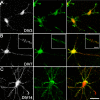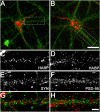Hyaluronan synthesis by developing cortical neurons in vitro
- PMID: 28287145
- PMCID: PMC5347017
- DOI: 10.1038/srep44135
Hyaluronan synthesis by developing cortical neurons in vitro
Abstract
Hyaluronan is a linear glycosaminoglycan that forms the backbone of perineuronal nets around neurons in the cerebral cortex. However, it remains controversial whether neurons are capable of independent hyaluronan synthesis. Herein, we examined the expression of hyaluronan and hyaluronan synthases (HASs) throughout cortical neuron development in vitro. Enriched cultures of cortical neurons were established from E16 rats. Neurons were collected at days in vitro (DIV) 0 (4 h), 1, 3, 7, 14, and 21 for qPCR or immunocytochemistry. In the relative absence of glia, neurons exhibited HAS1-3 mRNA at all time-points. By immunocytochemistry, puncta of HAS2-3 protein and hyaluronan were located on neuronal cell bodies, neurites, and lamellipodia/growth cones from as early as 4 h in culture. As neurons matured, hyaluronan was also detected on dendrites, filopodia, and axons, and around synapses. Percentages of hyaluronan-positive neurons increased with culture time to ~93% by DIV21, while only half of neurons at DIV21 expressed the perineuronal net marker Wisteria floribunda agglutinin. These data clearly demonstrate that neurons in vitro can independently synthesise hyaluronan throughout all maturational stages, and that hyaluronan production is not limited to neurons expressing perineuronal nets. The specific structural localisation of hyaluronan suggests potential roles in neuronal development and function.
Conflict of interest statement
The authors declare no competing financial interests.
Figures







Similar articles
-
Construction of perineuronal net-like structure by cortical neurons in culture.Neuroscience. 2005;136(1):95-104. doi: 10.1016/j.neuroscience.2005.07.031. Epub 2005 Sep 21. Neuroscience. 2005. PMID: 16182457
-
A pericellular hyaluronan matrix is required for the morphological maturation of cortical neurons.Biochim Biophys Acta Gen Subj. 2020 Oct;1864(10):129679. doi: 10.1016/j.bbagen.2020.129679. Epub 2020 Jul 2. Biochim Biophys Acta Gen Subj. 2020. PMID: 32623025
-
Experience-dependent development of perineuronal nets and chondroitin sulfate proteoglycan receptors in mouse visual cortex.Matrix Biol. 2013 Aug 8;32(6):352-63. doi: 10.1016/j.matbio.2013.04.001. Epub 2013 Apr 15. Matrix Biol. 2013. PMID: 23597636
-
Perineuronal nets provide a polyanionic, glia-associated form of microenvironment around certain neurons in many parts of the rat brain.Glia. 1993 Jul;8(3):183-200. doi: 10.1002/glia.440080306. Glia. 1993. PMID: 7693589
-
Hyaluronan synthesis supports glutamate transporter activity.J Neurochem. 2019 Aug;150(3):249-263. doi: 10.1111/jnc.14791. Epub 2019 Jul 9. J Neurochem. 2019. PMID: 31188471
Cited by
-
Perineuronal nets and the neuronal extracellular matrix can be imaged by genetically encoded labeling of HAPLN1 in vitro and in vivo.bioRxiv [Preprint]. 2023 Nov 30:2023.11.29.569151. doi: 10.1101/2023.11.29.569151. bioRxiv. 2023. PMID: 38076839 Free PMC article. Preprint.
-
An alginate-based encapsulation system for delivery of therapeutic cells to the CNS.RSC Adv. 2022 Feb 1;12(7):4005-4015. doi: 10.1039/d1ra08563h. eCollection 2022 Jan 28. RSC Adv. 2022. PMID: 35425456 Free PMC article.
-
Changes in hyaluronan deposition in the rat myenteric plexus after experimentally-induced colitis.Sci Rep. 2017 Dec 15;7(1):17644. doi: 10.1038/s41598-017-18020-7. Sci Rep. 2017. PMID: 29247178 Free PMC article.
-
Matters of size: Roles of hyaluronan in CNS aging and disease.Ageing Res Rev. 2021 Dec;72:101485. doi: 10.1016/j.arr.2021.101485. Epub 2021 Oct 9. Ageing Res Rev. 2021. PMID: 34634492 Free PMC article. Review.
-
An Extracellular Perspective on CNS Maturation: Perineuronal Nets and the Control of Plasticity.Int J Mol Sci. 2021 Feb 28;22(5):2434. doi: 10.3390/ijms22052434. Int J Mol Sci. 2021. PMID: 33670945 Free PMC article. Review.
References
-
- Spicer A. P., Augustine M. L. & McDonald J. A. Molecular cloning and characterization of a putative mouse hyaluronan synthase. J. Biol. Chem. 271, 23400–23406 (1996). - PubMed
-
- Spicer A. P., Olson J. S. & McDonald J. A. Molecular cloning and characterization of a cDNA encoding the third putative mammalian hyaluronan synthase. J. Biol. Chem. 272, 8957–8961 (1997). - PubMed
-
- Watanabe K. & Yamaguchi Y. Molecular identification of a putative human hyaluronan synthase. J. Biol. Chem. 271, 22945–22948 (1996). - PubMed
-
- Laurent T. C., Laurent U. B. & Fraser J. R. The structure and function of hyaluronan: An overview. Immunol. Cell Biol. 74, A1–A7 (1996). - PubMed
-
- Toole B. P. Hyaluronan: from extracellular glue to pericellular cue. Nat. Rev. 4, 528–539 (2004). - PubMed
Publication types
MeSH terms
Substances
LinkOut - more resources
Full Text Sources
Other Literature Sources
Research Materials

